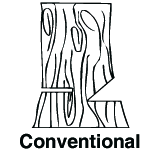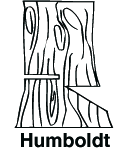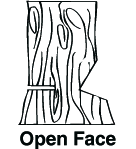Choose a chain saw with built-in safety features. Look for kickback guards that prevent the chain from hitting another object. Look for noise and vibration reduction features on new and used saws. A throttle interlock will prevent accidental throttle advance. Also, a high engine idle latch allows the operator to start the engine while holding the saw firmly on the ground. Choose a chain saw that is lightweight and has a cutting bar no longer than needed. Hand guards should be in place. The exhaust should be directed away from the operator on gas-powered machines. Before using a chain saw, read the owner’s manual. Know how to operate the chain saw properly. Periodically read the owner’s manual to keep the information fresh in your mind.
- Select a chainsaw with built-in safety features, including a chain kickback guard.
- A complete set of personal safety gear is recommended anytime a chainsaw is used.
- Clear an escape path before felling a tree.
- Keep the tree between you and the chainsaw when trimming downed trees.
|
Dressing for the Job
Dress in the proper work clothing before operating a chain saw. Wear cuffless pants and trim fitting clothing that allows for easy movement. Safety shoes or boots with non-slip soles and light non-slip gloves are a must. Wear a hard hat, eye protection and hearing protection. Protection for the legs, such as safety chaps, leggings or safety pads will provide maximum protection against cutting accidents.
Before Beginning Work
It is important to check the area and equipment before working. Work with a buddy if possible. They can give assistance and go for help if needed. Clear an escape path and the area where work will take place. Check the chain saw for loose screws and bolts and tighten them. Check the chain for the proper lubrication, tension and sharpness. Examine the guide bar for damage. Make sure the handles are clean and dry.
A well-maintained chain saw tends to be a safer saw. A good tool kit will help to assure continued operation of the chain saw. The tool kit should contain tools to repair the chain saw such as wrenches to fit all nuts and lugs on the chain saw, a screwdriver and an extra sparkplug. A round file and guide for touching up the chain and a flat file and depth gauge to file the depth guides should be included.
Beginning Work
Start the chain saw on clear ground and oil the chain. The chain should not move during idling. If it does, adjust the chain to stop. Grip the chain saw properly, and hold the running chain saw with both hands. When cutting through wood, remember the chain saw cuts quickly and will continue its downward path. Stay out of its path.
When moving from one place to another, carefully carry the chain saw with the guide bar cover on. Carry the chain saw so the blade is behind you. Carry the chain saw with the blade in front only if you are going down hill. Carry it so the muffler is away from the body. Also bring along chain saw oil, adjustment tools and the owner’s manual wrapped in a plastic bag.
Felling Trees
Felling trees can be dangerous, so safety is important. Look at the work area. The wind is unpredictable and can cause hazards, so cut trees on a still day. Look for widowmakers, spring poles and schoolmarms. Widowmakers are trees with broken or dead limbs or dead trees hung up in other trees that may fall on you. Spring poles are saplings or branches that are bent and held under tension by another tree. If the spring pole is cut or the other tree is removed from it, the sapling can snap up with a tremendous force and seriously injure someone. A schoolmarm is a tree with a prominent fork in the trunk making it difficult to predict which way it will fall. Look for other trees or buildings that a falling tree may encounter. If power lines are in the way, call the local power company, and they will help you.
Before felling a tree, identify a path where the tree will fall. Stand with feet well braced. Start the under cut notch one-quarter of the diameter of the tree on the side where it will fall. (Three common notches for directional felling are shown opposite: conventional, Humboldt and open face.) Back cut the opposite side parallel to the bottom notch an inch or so higher for the hinge. Slow down as the chain saw approaches the notch. Keep wedges nearby. Call a warning such as "timber" as the tree begins to fall. Get out of the way by moving off at a 45-degree angle.
Use extra care when cutting small trees. Trees four to five inches in diameter can usually be felled with one cut. Watch for bounce backs and limbs.
After the tree has been felled, begin trimming off the limbs and cutting the tree into manageable lengths. Trim the limbs from the opposite side keeping the tree stem between you and the chain saw. Never make cuts with the saw between your legs or straddle the limb to be cut. If working on a hill, stand on the uphill side. Work towards the top. If the saw seems pinched, begin a new cut on the opposite side, or use a wedge. Make all cuts at top speed on full throttle.
Bucking
Three common notches for directional felling are shown: conventional, Humboldt and open face.


 |
When cutting the trunk of a tree or bucking, make sure the chain does not hit the ground. An operator can cut many trees and not do damage to the chain that striking the ground one time can do. A dry chain is not safe.
If the trunk is supported along its entire length, make cuts from the top (called overbuck) one-third the diameter of the log deep, the entire length of the trunk. When this is completed, roll it over and make the final cut.
If the log is supported on one end, make the first cut (underbuck) one-third the diameter, then complete from topside by overbucking the upper two-thirds to meet the underbuck.
When the log is supported from both ends, cut one-third the diameter from the top (overbuck), then complete the cut by cutting upward from the underside (underbuck) to meet the first cut.
Kickbacks
Avoid sawing with the tip or nose of the guide bar. This greatly increases the chances of chainsaw kickback. Kickback can occur if the chain suddenly hits a solid object or takes too large of a cut. This can force the saw backward and upward and may result in a serious accident.
The chances of kickback can be reduced in the following ways. Hold the saw firmly with both hands. Grip the top handle with the thumb wrapped around it. Use a saw equipped with chain-brake or kickback guard. Watch for branches that can pinch the chain. Do not pinch the bar while in the log cut. Saw with the lower part of the bar, close to the bumper, not the top near the nose. Maintain high saw speed when entering or leaving a cut in the wood. Keep the chain saw chain sharp. Do not reach above shoulder height to cut, because you reduce your control over the saw. The chain is too close to your face in this position.
Refueling
Turn off the chain saw to refuel. Do not refuel overheated saws. Move away from the work area and only refuel with the proper gasoline. Wipe up any spills. Return the caps to the chain saw and gasoline can. Return the gasoline can to a safe place and continue working.
Cutting at Heights
Using a ladder when removing limbs from trees is very hazardous. Do not carry a chain saw up and down a ladder when the engine is running. Use a rope to hoist the chain saw up into the tree and then start the chain saw. Get into a stable position and keep a firm grip on the chain saw with both hands. Do not let the chain saw fall through the cut or it may strike your legs or other objects. Overhead cutting is extremely tiring and dangerous.
Using Wedges
| If power lines are in the way, call the local power company, and they will help you. |
When the chances of binding exist, use wedges. However, stop the chain if there is no danger of driving a wedge into the moving chain. Use only wooden, aluminum or plastic wedges. Do not use steel or iron wedges, as they may do considerable damage to the chain if struck. Position yourself and helpers such that they will not be hit by a wedge should the chain strike it. On windy days, for leaning trees or when trees must fall in a specific direction, wedges are essential. Two wedges are usually used. When the final cut is up to the proper depth for felling the tree, remove the chain saw. Shut the chain saw off and move it back to a safe position. Then tap the wedges with a sledge or maul to fell the tree.
Publication #: 2353
This Maine Farm Safety
Fact Sheet is part of an educational fact sheet series produced
by the University of Maine Cooperative Extension. For more information
on farm safety, contact your county Extension office.
Disclaimer and Reproduction Information: Information in
NASD does not represent NIOSH policy. Information included in
NASD appears by permission of the author and/or copyright holder.
More


